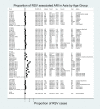The burden of respiratory syncytial virus in adults: a systematic review and meta-analysis
- PMID: 32052719
- PMCID: PMC7078512
- DOI: 10.1017/S0950268820000400
The burden of respiratory syncytial virus in adults: a systematic review and meta-analysis
Abstract
Respiratory syncytial virus (RSV) is the most common pathogen associated with acute lower respiratory tract infections in young children. RSV is also a major viral pathogen causing severe lung disease in the adult population, particularly among the elderly. We conducted a review of adult RSV studies published from January 1970 to February 2017 to determine the burden of disease among adults worldwide. There were no restrictions on health care setting or definition of RSV infection. A total of 1530 published studies were identified, 95 of which were included in this review. The incidence rates of hospitalised RSV acute respiratory tract infection (ARI) in adults >65 years old ranged from 7.3 to 13.0/105 population in Africa and Asia and from 190 to 254/105 population in the USA. Higher incidence rates (195-1790/105 population) were observed in adults ≥50 years old for outpatient or emergency visits in the USA. Of all ARI patients, RSV accounted for 1-10% in adults and 2-14% in patients with chronic diseases or transplantation. Given the limitations in the existing data, significant efforts should be made to generate evidence on the burden of RSV infections in adults and to estimate the potential impact of future preventive interventions.
Keywords: Acute respiratory infection; epidemiology; respiratory syncytial virus; surveillance.
Conflict of interest statement
M. Tin Tin Htar, J. C. Moïsi and D. L. Swerdlow are employees of Pfizer Inc. and hold company shares. M. S. Yerramalla was an employee of Pfizer Inc. at the time of study conduct.
Figures






References
-
- Stensballe LG et al. (2006) Atopic disposition, wheezing, and subsequent respiratory syncytial virus hospitalization in Danish children younger than 18 months: a nested case-control study. Pediatrics 118, e1360–e1368. - PubMed
-
- Rodriguez R and Ramilo O (2014) Respiratory syncytial virus: how, why and what to do. Journal of Infection 68, S115–S118. - PubMed
-
- Long SS, Pickering LK and Prober CG (2012) Principles and Practice of Pediatric Infectious Disease. Churchill Livingstone, Scotland: Elsevier Health Sciences.
-
- Mejias A and Ramilo O (2013) Defining the burden of respiratory syncytial virus infection. Jornal de Pediatria (Versão em Português) 89, 517–519. - PubMed
Publication types
MeSH terms
LinkOut - more resources
Full Text Sources
Medical

